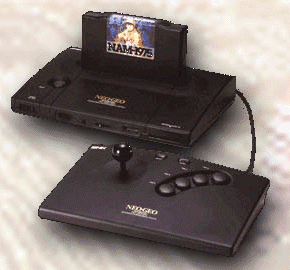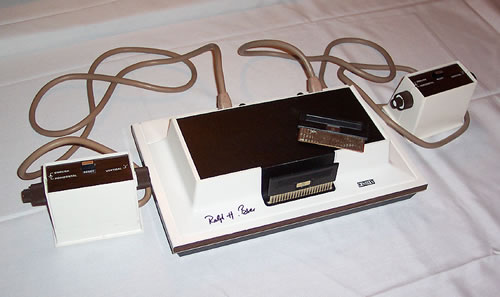|
|
|||||||||||||||||||||||||
|
Really Collectable Retro Game Consoles |
|||||||||||||||||||||||||
| Home |
In the thirty year history of the console gaming industry the push towards better systems has come around every five to seven years. For a segment of gamers who are pushing 40, as a way of recapturing memories of days gone by in their youth they are collecting the old game consoles. Atari 2600’s original Nintendo Entertainment Systems and Even Sega Master Systems are much in demand. Most of these systems are still relatively common and can picked up cheaply at garage sales, second-hand shops and on eBay. For the serious collector there are some forgotten consoles that have not just semimetal value but monetary value as well. Most of these systems were commercial failures. Some failed due to high price or the technology was too ahead of it’s time or maybe because there were already three or four other systems in the market and just couldn’t support another system. Other systems make the list for entirely other reasons. The first Sega system to launch in North America doesn’t make this list because it was a failure in the market but because of the loyalty of the fan base. Back at the end of the 1980’s, Sega Master System owners were absolutely insistent that the Master System was superior to the Nintendo Entertainment System even though for every one Master System owner there were ten NES owners. This sort of makes the Master System the Macintosh of console gaming. These gamers who were enthusiastically extreme promoters of the Sega Master System are probably are the first of what are now known as ‘FanBoys’ The Sega Master System was close to the last commercially sold devices that used the Zilog Z80 as it’s primary CPU. TheZ80 was the most commonly used CPU’s in the early days of the personal computer industry. Once IBM put their PC on the market the Intel CPU became dominant, relegating the Zilog to Game consoles and other devices.
After the failures of the 5400 and 7800 systems Atari, the company that single handed made video gaming a billion dollar business made one last attempt at doing their own console in the fall on 1993 when they introduced the Jaguar. At the time that gamers had made the move from 8 bit systems to 16 bit Atari’s Jaguar was the first 64 bit system on the market. At introduction the Jaguar was priced at $249.99. The games that were available at launch received poor reviews. After the initial launch there were very few games One of the biggest reasons that consumers stayed away from the Jaguar was the controller that came with the system. It looked like a combination of a standard d-pad controller with a telephone keypad attached. In mid 1995 as an attempt to prop up sagging sales and to cash in on the CD-ROM popularity of the time Atari introduced the Jaguar CD drive add-on. By the end Sega and Nintendo were waging war to be the leader of console gaming both losing to Sony with the newly launched Playstation. As the Sega Saturn floundered after it’s introduction in the end of 1995 was evidently clear that there was no room in the market for the Jaguar. Atari folded their hardware division and became a developer of game software.
SNK a Japanese developer of video arcade machines was faced with a dilemma in the late 1980’s, With the decline in video arcades and the rise of home consoles after the introduction of the original Nintendo Entertainment System, SNK had to put out a home console or face extinction. In 1990 the console from SNK called the Neo Geo arrived in stores in Japan and the United States. At launch the price for a Neo Geo system was steep. 649.99 for the Gold package which included two controllers, a memory card and a game called Magician Lord. There was also the silver package available for 399.99 which came with the system and one controller. At the dawn of the 1990’s video games were still viewed as a way ‘Those Kids’ waste time very few parents were willing to pay for a Neo Geo. Another problem that lead to the poor adoption of the Neo Geo was the marketing of the unit or the lack of marketing. SNK never aired any commercials took out any print advertising in the United States. Independent game developers avoided the Neo Geo because of the low market share didn’t make it worthwhile to develop games for the Neo Geo. As a result the only games for the Neo Geo were those developed by SNK. The Neo Geo could only achieve nothing more than a cult following among a niche of hard core users. Despite it’s very low market share Neo Geo had a life span that lasted through out the 1990’s. Production of Neo Geo consoles ended in 1997 even though SNK was still producing games for the system for several more years. The last game to be put out for the Neo Geo was Samurai Shodown V Special in 2004. SNK exited the hardware business claiming rampant piracy. At the time many asked did the high prices charged by SNK for both the consoles and the games lead to the piracy that ultimately caused SNK to fold or was it competition from more powerful and less expensive systems that brought the end of the Neo Geo.
The demise of the Atari Jaguar can be considered to be a slow burn compared to the crash and burn known as 3D0. 3D0 didn’t even manufacture the consoles themselves. They licensed their technology to other electronics manufacturers. Panasonic, Sanyo, and Goldstar manufactured the consoles. By licensing their technology to third party manufacturers, 3D0 was planning a sort of Microsoftification of the Gaming industry. 3D0 charged lower royalties to independent game developers hoping to build a massive game library to attract players to 3D0 systems. When Panasonic introduced the first 3D0 console dubbed the FZ-1 R.E.A.L. 3DO Interactive Multiplayer in October of 1993 at a staggering price of $699.99, dropping to $499.99 just a year later which were in line with the price of the Sanyo and Goldstar 3D0 machines.The low cost licensing from 3D0 was attractive to independent game developers at first but when gamers shied away because of the high cost the developers migrated to other systems. In the very little marketing done by 3D0 they promoted it not just as a game box but a multimedia system by playing Music CD’s and Video CD’s with an extra mpeg decoder board. Just about all of today’s gaming consoles go beyond playing games and are now home multimedia hubs that can play music and movies but back in 1993 that was something that people just weren’t ready for, the 3D0 tried to be all things for all people and it became an overpriced piece of hardware that nobody wanted.
In the mid 1990’s video gaming moved from a niche industry into the mainstream when Sony became the first traditional consumer electronics company to produce a commercially successful video game console. In 1995 Apple Computer got into video gaming with the Pippin. The Pippin was a scaled down Power PC based Macintosh computer. The pippin may have been a gaming box but Apple also had aimed the Pippin as a learning tool as well. The controller had a Powerbook style track ball designed for pointing and clicking that would be required for educational multimedia software. As with other disc based game systems some kind of additional storage is required for saving game data, Sony Playstations and Nintendo’s game cube had memory cards, Xboxes have internal hard drives and the Wii has internal flash memory. The Pippin had a floppy disc drive that was an after market option, not even built in. Apple licensed other companies to build the Pippin, contrary to the ‘we develop it and we build it’ model that people expect from Apple. Japanese electronic toy maker Bandai was the first and only company to buy a license from Apple to build the Pippin. The Pippin launched in Japan at the end of 1995 and in the United States on September 1st 1996. At $599.99 the Pippin was the most expensive video game system on the market that year. The Pippin was a system that had practically no support from game developers when it launched. There were twelve titles available when the system launched and six of those came bundled with the Pippin. It doesn’t take a economics degree to see that nobody would pay 600 dollars to buy a video game system with virtually no library of games to play on it. When Steve Jobs returned to Apple in 1997, The Pippin along with the Newton that got chopped.
Magnavox isn’t exactly a company that comes to the minds to the minds of modern gamers, but back in 1972 it was Magnavox that brought video games into the home. The graphics were crude at best and required plastic overlays that attached to front of TV screens to give the appearance of graphics since the Odyssey could only generate white dots on the screen. Gamers had to use score cards to keep track of score in any given game. The Odyssey only had logic circuits and a video signal generator that meant that there was no sound capability. Magnavox was considering an add on sound module for the Odyssey shortly after launch but shelved the idea believing that early gamers wouldn’t want to keep paying for accessories after buying the systems. Magnavox sued Nolan Bushnell the creator of Pong and founder of Atari for patent infringement, after settling the lawsuit Atari released the 2600 and Magnavox put out the instantly forgettable Odyssey 2. Magnavox went on to sue other makers of home video game consoles and won or settled all the lawsuits they launched. In 1985 just before their launch in North America, Nintendo sued Magnavox to invalidate their patents claiming that a game called Tennis for Two by William Higinbotham was the first video game, Nintendo lost because the court found that because Tennis for Two doesn’t have a circuit for generating a video signal for use on a TV it cannot be classified a video game. Magnavox will always be known as the company that put out the very first home video game console, but should also be known as the first patent troll in the video game industry.
|
||||||||||||||||||||||||
| Blog | |||||||||||||||||||||||||
| Commentary | |||||||||||||||||||||||||
 Custom Search
|
|||||||||||||||||||||||||
 |
|||||||||||||||||||||||||

 Sega Master System
Sega Master System Atari Jaguar
Atari Jaguar SNK NeoGeo
SNK NeoGeo 3D0
3D0 Apple/Bandai Pippin
Apple/Bandai Pippin Magnavox Odyssey
Magnavox Odyssey